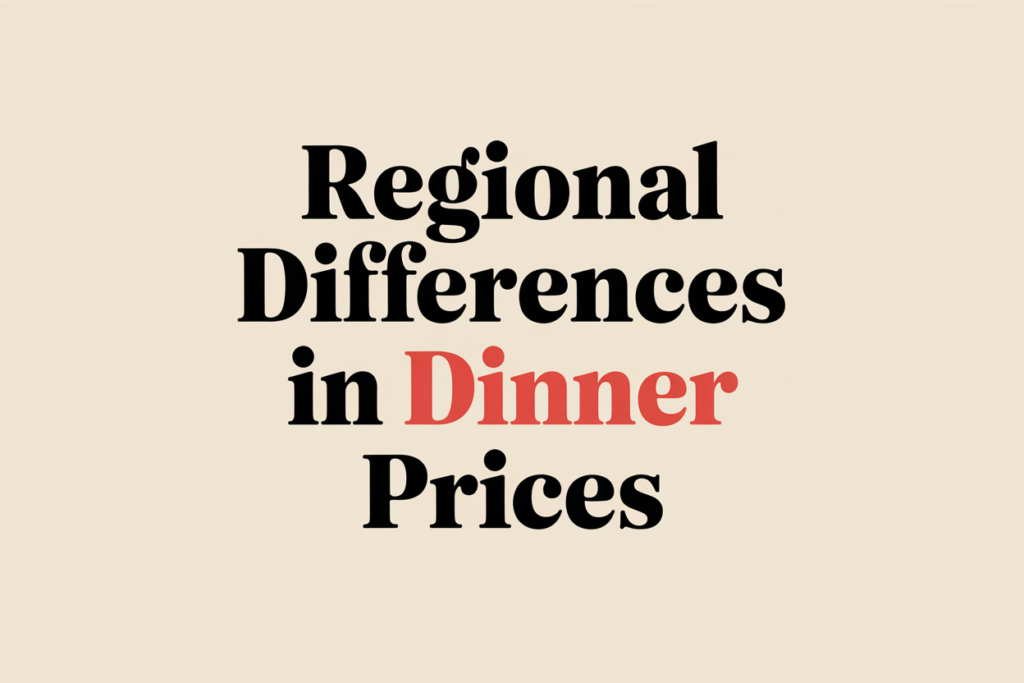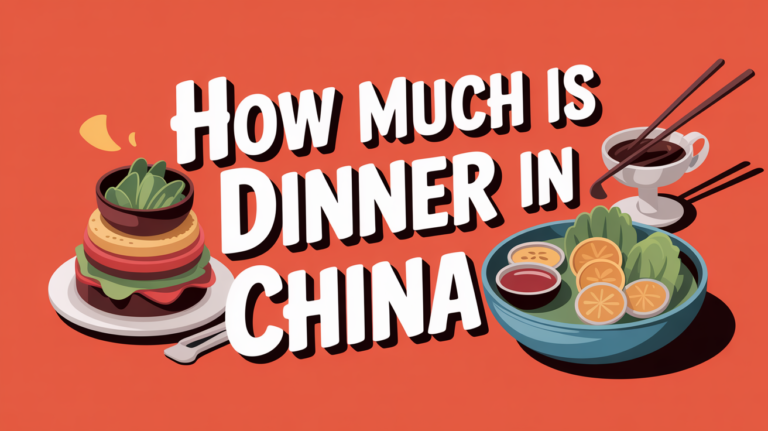Wondering how much dinner costs in China? On average, a meal in a local restaurant ranges from $3 to $10 USD, while a fine dining experience can cost $30 or more. Street food offers even cheaper options, with delicious meals available for under $2.
When planning a trip to China, knowing what to expect in terms of food costs is essential. From the bustling street food stalls to upscale restaurant dining, prices can vary greatly depending on where you are. Many travelers are unsure about how much they’ll spend on dinner, especially when comparing it to dining costs back home. But don’t worry—you’re in the right place for a simple, clear breakdown of meal prices across China. Let’s walk through each dining option and explore how much you’ll typically spend, with real examples to guide your budgeting.
Contents
- 1 Understanding the Average Dinner Cost in China
- 2 Regional Differences in Dinner Prices
- 3 Budget Dining: How to Enjoy Affordable Meals in China
- 4 Luxury Dining in China: What to Expect
- 5 Additional Factors Affecting Dinner Prices in China
- 6 Tipping in China: Is It Common for Dinner?
- 7 How Dinner Prices in China Compare to the USA
- 8 Tips for Budgeting Your Meals While Visiting China
- 9 FAQ
- 10 Conclusion
Understanding the Average Dinner Cost in China
Dinner prices in China can vary significantly depending on where you choose to eat. Whether you prefer quick street food or a comfortable sit-down restaurant, the price you pay will depend on the city, the type of meal, and the restaurant’s level of service.
Average Dinner Prices in Major Cities
In major cities like Beijing, Shanghai, and Guangzhou, you’ll find a wide range of options. On average, a meal at a local restaurant will cost around 30-80 CNY (approximately $4.5-$12 USD). For a basic but satisfying dinner, expect to pay around 40 CNY (about $6 USD). In comparison, meals in more tourist-centric areas might be slightly higher.
Here’s a simple breakdown of what you can expect:
| City | Average Price (CNY) | Average Price (USD) |
|---|---|---|
| Beijing | 40-80 | $6-$12 |
| Shanghai | 50-100 | $7.5-$15 |
| Guangzhou | 30-70 | $4.5-$10.5 |
Tip: If you’re visiting Shanghai or Beijing, prices in more upscale districts or popular tourist spots like Wangfujing in Beijing or The Bund in Shanghai can be on the higher end. Check out this guide to Shanghai food prices for more details on restaurant costs.
Comparison between Street Food, Mid-range, and Fine Dining
China is famous for its diverse food culture. The prices vary greatly depending on what you choose to eat. Street food is an excellent way to experience authentic Chinese flavors without spending much. A bowl of noodles, dumplings, or baozi (steamed buns) can cost as little as 10-20 CNY (around $1.5-$3 USD). For many, this is an affordable and delicious option.
On the other hand, a mid-range restaurant will offer a more comfortable atmosphere and a larger menu. A typical meal here will cost between 60-150 CNY (approximately $9-$22 USD), with prices varying by location. These restaurants often serve a variety of regional dishes from different parts of China.
If you’re looking to indulge, fine dining options are available. Prices for a luxurious dinner can start around 200 CNY (about $30 USD) per person and can go up significantly depending on the restaurant’s prestige. You can expect premium ingredients, a beautiful ambiance, and exceptional service. Restaurants like Da Dong Roast Duck in Beijing or M on the Bund in Shanghai offer exquisite dining experiences that can cost upwards of 500-1000 CNY per meal.
| Meal Type | Average Price (China) | Average Price (USA) |
|---|---|---|
| Street Food | $1 – $3 | $5 – $10 |
| Mid-range Meal | $6 – $22 | $20 – $50 |
| Fine Dining | $30 – $150 | $50 – $100+ |
Link: For more details on how to find budget-friendly street food in Beijing, check this Beijing street food guide.
Regional Differences in Dinner Prices

Dinner prices in China aren’t the same across the country. Depending on the region you’re in, you may find that meals are more expensive or more affordable. Let’s explore how the cost of dining varies in the north and south of China.
Northern China vs Southern China: Price Variations Explained
Northern China is known for its hearty dishes, often featuring wheat-based foods like dumplings, noodles, and pasta. Cities like Beijing and Xi’an are famous for these types of meals. The cost of dining here tends to be a bit lower, with street food and local restaurants offering affordable meals, as we discussed earlier.
In southern China, the food culture shifts. Rice is more common than wheat, and you’ll find rice noodles, seafood, and sautéed vegetables. Cities like Guangzhou and Hong Kong typically have higher food costs. Particularly in Hong Kong, which is a global metropolis, prices can be significantly steeper, even for street food. Dining at local restaurants in Guangzhou may cost a little more than in northern cities due to its position as a major trading hub.
Tip: When traveling in southern China, especially cities like Hong Kong and Guangzhou, you might notice higher prices due to their popularity as tourist destinations. Explore Guangzhou’s dining scene for more details on what to expect.
Price Comparison of Northern and Southern China
| Region | Average Dinner Price (CNY) | Price Range (USD) |
|---|---|---|
| Northern China | 30-80 | $4.5-$12 |
| Southern China | 40-100 | $6-$15 |
Budget Dining: How to Enjoy Affordable Meals in China
Eating in China doesn’t have to break the bank. With a little planning, you can enjoy delicious meals without spending a lot of money.
Top Affordable Options for Dinner
One of the best ways to save money on meals is to dive into local street food. These small vendors offer a variety of options that are both tasty and affordable. A bowl of noodles or steamed dumplings can cost under 20 CNY (around $3 USD). These meals are great for trying authentic flavors while keeping your expenses low.
Local diners or small eateries are another excellent option for budget-conscious travelers. These spots usually offer simple, home-style dishes at reasonable prices, often under 40 CNY per meal. A dish of fried rice, stir-fried vegetables, or a small meat portion with rice is usually filling and very affordable.
If you’re exploring larger cities, especially in Beijing or Shanghai, you’ll also find budget restaurants that cater to locals, where a hearty meal might only cost around 50 CNY ($7.5 USD).
Tip: If you’re looking for an authentic and budget-friendly experience, try heading to local markets. In Beijing, places like Wangfujing market offer delicious and cheap options to try local flavors without the high price tags. To get an idea of Beijing’s budget food, check this guide.
Link: For further insights into budget-friendly eating in Shanghai, take a look at this Shanghai food guide.
Luxury Dining in China: What to Expect
If you’re looking to indulge in a special dining experience while in China, there are plenty of luxury restaurants offering exquisite meals. These upscale spots provide an elevated dining atmosphere, focusing on premium ingredients, world-class service, and unique dishes. Here’s what you can expect when dining at high-end restaurants in major Chinese cities.
Pricing for Fine Dining Restaurants and Exclusive Locations
Fine dining in China is often linked to renowned chefs, top-tier ingredients, and meticulously designed settings. The cost for a luxury dinner in a reputable restaurant typically ranges from 200 CNY to 1,000 CNY per person (about $30-$150 USD). The price varies based on the restaurant’s prestige, location, and the type of cuisine offered. These fine-dining spots not only serve exquisite Chinese cuisine but also offer international dishes and innovative fusion menus.
For instance, enjoying Peking Duck at a high-end restaurant like Da Dong in Beijing might cost around 400 CNY ($60 USD) per person. Alternatively, an upscale restaurant like M on the Bund in Shanghai could offer a luxurious set dinner ranging from 500-1,000 CNY ($75-$150 USD) per person. These venues often provide an immersive dining experience with stunning views, exceptional ambiance, and well-curated menus that elevate the dining journey.
| Restaurant Type | Average Price (CNY) | Average Price (USD) |
|---|---|---|
| Fine Dining | 200 – 1,000 | $30 – $150 |
| Peking Duck (Da Dong) | 400 | $60 |
| M on the Bund (Shanghai) | 500 – 1,000 | $75 – $150 |
Tip: If you’re looking for an exclusive dining experience, try restaurants like M on the Bund in Shanghai or Da Dong Roast Duck in Beijing.
Link: For more insights into Michelin-starred restaurants in China, visit this guide to Michelin dining in China.
Additional Factors Affecting Dinner Prices in China
While the type of restaurant plays a significant role in how much you’ll spend on dinner, several other factors can affect food prices in China. Here, we’ll look at the influence of location, seasonal variations, and local customs on dining costs.
Dining Location: City vs Countryside
Urban vs rural areas make a big difference when it comes to the cost of dining. In larger, more tourist-heavy cities like Shanghai or Beijing, you’ll typically find higher food prices. These cities attract both international visitors and locals who can afford higher prices, so dining costs tend to be more expensive.
On the other hand, in smaller cities or rural areas in China, you’ll find meals are much more affordable. For example, in cities like Xi’an or Chengdu, local food options can be quite inexpensive. Meals in these places, whether at a small restaurant or street food vendor, often cost far less than in the large, commercial cities. You can expect to pay around 15-30 CNY (approximately $2-$4 USD) for a local dish in these less touristy areas.
Tip: If you want to save money while traveling through China, try dining in the smaller cities or rural regions where you’ll find authentic, cheap meals. For more about dining in rural China, check out this guide to dining in rural areas.
Time of Year: Seasonal Variations
Seasonal changes also affect the cost of food in China. During peak tourist seasons like the Chinese New Year (usually in January or February), the prices of food and services tend to rise. During these times, restaurants may offer special festive menus, but they can also charge higher prices.
Off-season dining is a great way to get better deals. For instance, autumn and spring are considered off-seasons in most cities, so you might find better prices at local eateries. These seasons also offer a greater variety of seasonal ingredients, which can influence the meal prices.
Link: You can read more about the impact of Chinese New Year on prices at China Highlights.
Tipping in China: Is It Common for Dinner?

In many countries, tipping is a standard part of dining, but the practice in China can be quite different. It’s important to understand how tipping works, or rather, doesn’t work in China, so you can navigate your dining experience smoothly.
Explanation of Tipping Etiquette
In China, tipping is generally not expected. The culture of tipping is not as common as in countries like the United States or Europe, and most restaurants, especially in smaller cities, do not encourage it. In fact, many restaurants already include a service charge in the bill. Fine dining spots may sometimes add a small service charge, but this is usually reflected directly in the bill.
It’s worth noting that in tourist areas or international hotel restaurants, staff may appreciate a tip, but it’s never mandatory. For local eateries, tips are often seen as unnecessary or even inappropriate. Instead, if you want to show appreciation for great service, it’s more common to express gratitude verbally.
Tip: If you’re dining in international restaurants in China or places that cater to tourists, you may want to check the bill first to see if a service charge has been added. If not, tipping is optional.
For more on tipping etiquette in China, you can read this tipping guide.
Link: Learn more about Chinese dining culture and tips for travelers from this dining etiquette guide.
How Dinner Prices in China Compare to the USA
Traveling from the USA to China can give you a big surprise when it comes to meal prices. In general, dining in China is more affordable than in the USA, especially for basic meals. Here, we’ll compare what you can expect to spend in both countries.
Price Comparison: Dinner in China vs. USA
In the United States, eating out tends to be more expensive. A typical meal in a mid-range restaurant in the US can cost between $20-$50 USD per person, not including tips. On the other hand, a similar meal in China at a mid-range restaurant may cost around $9-$22 USD.
For street food, the difference is even more striking. In China, street food meals like dumplings, noodles, and skewers often cost less than $3 USD, whereas the cost of street food in the US can range from $5-$10 USD, depending on the location.
Here’s a breakdown of dinner price comparison between the two countries:
| Meal Type | Average Price in China (USD) | Average Price in USA (USD) |
|---|---|---|
| Street Food | $1-$3 | $5-$10 |
| Mid-Range Meal | $6-$22 | $20-$50 |
| Fine Dining | $30-$150 | $50-$100+ |
Tip: If you’re visiting China, you’ll definitely save money on dining compared to the US. However, keep in mind that prices can vary depending on where you eat. For a deeper look into the cost of dining in major US cities, check out this cost of living guide.
Link: You can read more on the price differences between China and the US in this China vs USA cost comparison for a clearer breakdown.
Tips for Budgeting Your Meals While Visiting China
When planning your trip to China, it’s crucial to budget wisely for your meals. With careful planning, you can enjoy all that China has to offer without overspending. Here are some tips for keeping your dining costs down while still experiencing authentic local cuisine.
How to Save Money on Dining Without Sacrificing Experience
- Eat Like a Local: Stick to local restaurants or street food stalls. These offer great-tasting meals at a fraction of the price you’d pay in a touristy area. Dishes like noodles, dumplings, and baozi (steamed buns) are delicious and incredibly affordable.
- Use Food Delivery Services: Many Chinese cities have food delivery apps like Meituan and Eleme that often offer great deals, discounts, or special offers for online orders. This can help you save money while still enjoying a variety of dishes from local restaurants.
- Avoid Tourist Traps: Restaurants near major tourist attractions often have inflated prices. Explore neighborhoods where the locals dine, such as hutongs in Beijing or local markets in Guangzhou.
- Choose Your Accommodation Wisely: If your hotel offers complimentary breakfast or meal deals, take advantage of it. Eating at your hotel restaurant can often be cheaper than going out for every meal.
- Don’t Over-order: In China, many restaurants offer family-style meals where you order several dishes to share. Be mindful of portion sizes, as it’s easy to order more food than you can finish.
Tip: Always check reviews or ask locals for recommendations on the best affordable restaurants in the area. Google Maps or apps like TripAdvisor often list the most popular local spots.
Link: For tips on budget travel in China, check out this budget travel guide.
FAQ
1. How much does a typical dinner cost in China?
A typical dinner in China can range from 30 CNY to 80 CNY (approximately $4.5 – $12 USD) at a local restaurant. Street food is even more affordable, often costing under 20 CNY (around $3 USD).
2. Is dining in China cheaper than in the USA?
Yes, in general, dining in China is much cheaper than in the USA. A mid-range meal in China costs about $9 – $22 USD, while in the USA, it can range from $20 to $50 USD or more.
3. What are the best ways to save money on meals in China?
To save money, try eating at local restaurants, opting for street food, and avoiding tourist-heavy areas. You can also use food delivery apps like Meituan and Eleme to find deals.
4. Are there any fine dining options in China?
Yes, China offers many luxury dining experiences. Expect to pay around 200 CNY – 1,000 CNY (about $30 – $150 USD) for an upscale meal. Popular fine dining restaurants like M on the Bund in Shanghai and Da Dong in Beijing provide exceptional experiences.
5. Do I need to tip in China?
Tipping is not commonly expected in China, particularly in local restaurants. Some high-end restaurants may add a service charge to the bill, but it’s not mandatory to tip.
Conclusion
Understanding dinner prices in China can be tricky if you’re unfamiliar with the local food culture, but it doesn’t have to be overwhelming. By exploring local dining options, embracing street food, and avoiding tourist traps, you can enjoy delicious meals without draining your wallet. Whether you’re in Beijing, Shanghai, or a smaller city, there’s something for every budget.
From street food to fine dining, China offers a wide range of dining experiences that cater to all types of travelers. So, whether you’re looking for an affordable meal or planning to indulge in luxury dining, you’ll find plenty of options that suit your needs.
Remember, dining in China offers both incredible value and an unforgettable culinary adventure. Now that you have a clearer picture of what to expect, start planning your meals accordingly to ensure you have a great experience without worrying about the cost.

